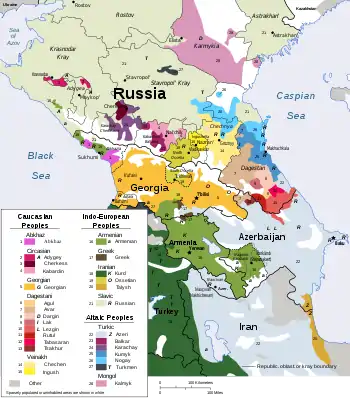Godoberi language
Godoberi (also spelled Ghodoberi; self-designation Gijbdilhi mitts; other names include also called годоберинский язык, ღოდობერიული ენა, годоберийский язык, гъибдилIи мицци, Ɣibdiƛi micci, Godoberin is an Andic language of the Northeast Caucasian language family spoken by the Godoberi in southwestern Dagestan, Russia. It is spoken by approximately 3,250 people.[1][3] There are only two dialects - Godoberi and Zibirhali, which differ mainly in pronunciation.[4] The Endangered Languages Project classifies the language as endangered based on the number of native speakers.[3]
| Godoberi | |
|---|---|
| ГъибдилIи мицци Ɣibdiƛi micci | |
| Native to | North Caucasus |
| Region | Southwestern Dagestan |
Native speakers | 3,250 (2007)[1] |
Northeast Caucasian
| |
| Language codes | |
| ISO 639-3 | gdo |
| Glottolog | ghod1238 |
| ELP | Ghodoberi[2] |
History
The history of the Godoberis is unknown. The Godoberi language is the main thing distinguishes the cultural group from other groups in the area. When compared to other Andic languages, Godoberi is most similar to Chamalal and Botlikh. Some words are borrowed from by Avar, Turkish, and Arabic. After being incorporated into the Russian Empire in the 19th century and then ruled by the Soviet Union in the 20th century, there is a strong Russian influence in the Godoberi language.[4]
Geographic Distribution
Native speakers of Godoberi live in two villages: Godoberi (Gjudu in Godoberi) and Zibirhali (Shalu in Godoberi). These villages are located in the mountains on the left bank of the Andi-Koisu River in Southwest Dagestan, a republic of Russia.[4][3]
Status
Godoberi is not a written language, and it is used only in the home. Schools teach Avar and Russian. Native speakers of Godoberi use Avar or Russian as a written language. These two languages are also used when speaking to people from neighboring communities. The number of Godoberi speakers appears to have been stable for the last 40 years. [4]
Phonology
Diphthongs are found only in Godoberi and in no other Daghestanain languages (example: c'ai 'fire').[5] There are 13 phonemic vowels: i, e, a, o, u, i:, e:, a:, o:, u:, ˜i, ã, ˜u. The accent system is extremely complex, especially for nouns.[5]
| initial stress
(H!H) |
initial stress
(HL) |
initial/prefinal/final
(HH) |
final
(HL-B) |
final/prefinal
(HL!) |
final/prefinal
(LL) |
final/initial
(HH!) |
final/initial
(LL-B) |
final/prefinal/initial
(HH-B) | |
|---|---|---|---|---|---|---|---|---|---|
| Nominative | gédu 'cat' | íča 'mare' | ímu 'father' | qučá 'sheepskin' | buRá 'bull' | haí 'eye' | łerú 'feather' | set'íl 'finger' | ziní 'cow' |
| Genitive | géduLi 'cat' | íčLi 'mare' | imúLi 'father' | qučiLí 'sheepskin' | buRáLi 'bull' | háiLi 'eye' | łéruLi 'feather' | sét'ilaLi 'finger' | zináLi 'cow |
| Dative | gédułi 'cat' | íčałi 'mare' | ímułi 'father' | qučiłí 'sheepskin' | buRałí 'bull' | haiłi 'eye' | łérułli 'feather' | sét'ilałi 'finger' | zínałi 'cow' |
| Ergative | gédudi 'cat' | íčadi 'mare' | imudí 'father | qučidí 'sheepskin' | buRadí 'bull' | haidí 'eye | łérudi 'feather' | sét'iladi 'finger | zinadí 'cow' |
Grammar
Morphology
Singular words have three genders: masculine, feminine, and neuter. Plural words lack those three genders and instead have two noun classes: human or inanimate object. There are two types of adjectives: primary and participles. A majority of the primary adjectives do not have gender. The four types of participles are past, present, future, and non-future negative.[5] The numerical system does not vary greatly from other languages. Verb morphology is also regular compared to other languages in the Andic language family.
References
- Godoberi at Ethnologue (18th ed., 2015)
- Endangered Languages Project data for Ghodoberi.
- "Ghodoberi". Endangered Languages Project.
- Kolga, Margus (2001). The Red Book of the Peoples of the Russian Empire. Tallinn: NGO Red Book.
- Kibrik, Aleksandr (1996). Godoberi. Munchen: Lincom.
Further reading
- Margus Kolga; Igor Tõnurist; Lembit Vaba; Jüri Viikberg (1993). "The Godoberis". The Red Book of the Peoples of the Russian Empire.
